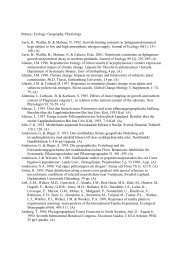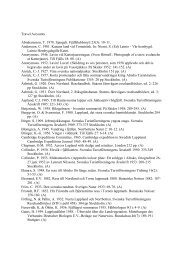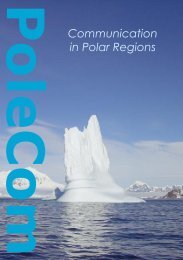Ladda ner årsbok 2008 (6,5 MB) - Polarforskningssekretariatet
Ladda ner årsbok 2008 (6,5 MB) - Polarforskningssekretariatet
Ladda ner årsbok 2008 (6,5 MB) - Polarforskningssekretariatet
Create successful ePaper yourself
Turn your PDF publications into a flip-book with our unique Google optimized e-Paper software.
Already data from 2006 have shown that the<br />
spectrum of atmospheric neutrinos agrees<br />
with predictions from theory and simulations<br />
of the detector. Data from the 2007 configuration<br />
of IceCube, with 22 strings, have been<br />
analyzed and new limits have been set on<br />
the neutrino flux. A conclusive signal from<br />
extraterrestrial neutrinos is yet to be found.<br />
Successful work<br />
After a day of acclimatisation the work began<br />
to set up the drill for the drilling season. So<br />
many hoses to drag, cables to connect, motors<br />
to start, heaters to tune in, new pumps to<br />
install. The first week was certainly full of<br />
hard work! The altitude of 2 800 metre, a<br />
humidity of 0% and the cold did its best to<br />
delay us, but we were nevertheless able to start<br />
drilling just a few days after schedule.<br />
Despite this and the fact that the 13th hole<br />
was the first hole we could drill without<br />
interruption, this season was the most<br />
successful so far. The drill crew managed<br />
to drill 18 holes and actually finished a few<br />
days ahead of schedule, far better than most<br />
people had expected. After a quick teardown<br />
of the drill camp and a move to the new<br />
location for the next season we found ourselves<br />
again sitting in a Hercules pondering the<br />
opportunities that had been given to us.<br />
Att studera universum med neutrinoteleskopet IceCube<br />
Neutrinoteleskopet IceCube håller på att byggas vid den geografiska Sydpolen. Ett neutrinoteleskop<br />
har som syfte att detektera neutrinopartiklar. Liksom för vanliga teleskop, som<br />
detekterar foto<strong>ner</strong>, studeras kosmologiska fenomen för att öka förståelsen för universum.<br />
Man hoppas finna svar på grundläggande frågor inom astrofysik och kosmologi, som<br />
kosmiska strålningens ursprung och mörk materias beskaffenhet. När neutrinopartiklar<br />
reagerar i den antarktiska isen skickas så kallat Cherenkovljus ut. Genom att observera<br />
detta ljus kan man indirekt detektera neutrinopartiklarna.<br />
Den nuvarande IceCube-detektorn består av 2 400 digitala optiska moduler som installerats<br />
på 40 strängar på ett djup mellan 1,5 och 2,5 km i isen. Den antarktiska sommarsäsongen<br />
2007/08 var mycket framgångsrik med 18 nyinstallerade strängar. Vid slutet<br />
av säsongen testas alla strängar, de optiska modulernas positio<strong>ner</strong> kalibreras och deras<br />
tidmätning verifieras. Redan data från 2006 visade att spektrumet av atmosfäriska neutrinopartiklar<br />
överensstämmer med förväntningarna. Data från 2007 har analyserats och nya<br />
gränser har satts för flödet av neutrinopartiklar från universum.<br />
Figure 3<br />
The IceCube lab. The towers on either<br />
side serve as cable entries from<br />
the detector strings. Photo: Henrik<br />
Johansson<br />
åRSBoK YEARBooK <strong>2008</strong><br />
23








